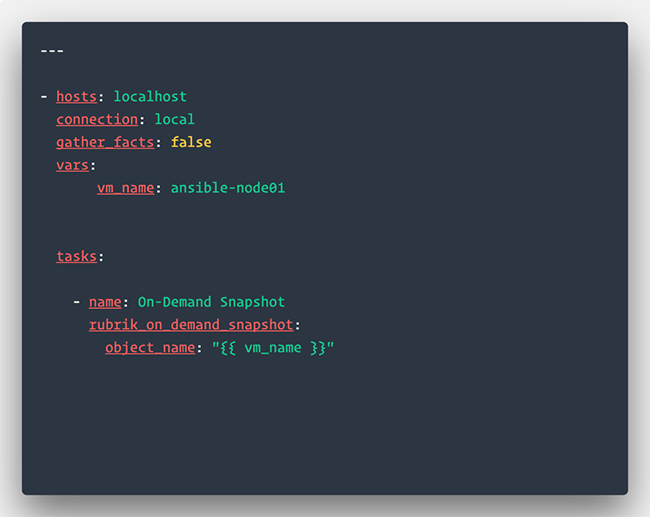Automation is at the heart of Rubrik. Whether we’re automating our test framework or making our APIs as easy to consume as possible through our Python and Go SDKs, we’re always looking for ways to help our users increase automation adoption. When speaking with our customers, it’s clear that automation is also top of mind for them, with infrastructure-as-code being a common theme. That’s why I’m happy to announce the availability of the Rubrik Modules for Red Hat Ansible!
Ansible is an open source orchestration tool that allows you to provision, manage, and codify your infrastructure. Ansible uses the language Playbooks for configuration, deployment, and orchestration. You can simply define the desired infrastructure configuration in your Playbook, and Ansible will update the target environment in an idempotent manner.
An Ansible module is responsible for understanding API interactions and exposing the resources from a given infrastructure, platform, or SaaS offering to Ansible. The initial release of the Rubrik Modules for Ansible includes:
- rik_assign_physical_host_fileset
- rubrik_cluster_version
- rubrik_job_status
- rubrik_assign_sla
- rubrik_bootstrap
- Rubrik_on_demand_snapshot
- Rubrik_end_user_authorization
- rubrik_nas_fileset
- rubrik_physical_host
- rubrik_dns_servers
- rubrik_managed_volume
- rubrik_physical_fileset
Let’s walk through an example of how Playbook Ansible works. Using the Rubrik Modules for Ansible, you can write a file that automatically takes an on-demand snapshot of a vSphere VM. By including this functionality in your application deployment process, you can quickly recover workloads by utilizing the Rubrik Live Mount and Instant Recovery functionality.

This is just one of many possible use cases. More than anything, we are excited to see what our customers come up with!
Ansible enables a single workflow for managing your Rubrik cluster, in addition to existing infrastructure, cloud, and SaaS offerings. Moving away from the manual repetitive use of point-and-click UIs to infrastructure-as-code enables a new agility for development teams to bring applications to production without sacrificing the oversight of the operations team.
For a quick overview of how to get started with the Rubrik Modules for Ansible, check out the video below:
To try the new Rubrik Modules for Ansible, visit the repository on GitHub. Don’t hesitate to contribute additional functions!
